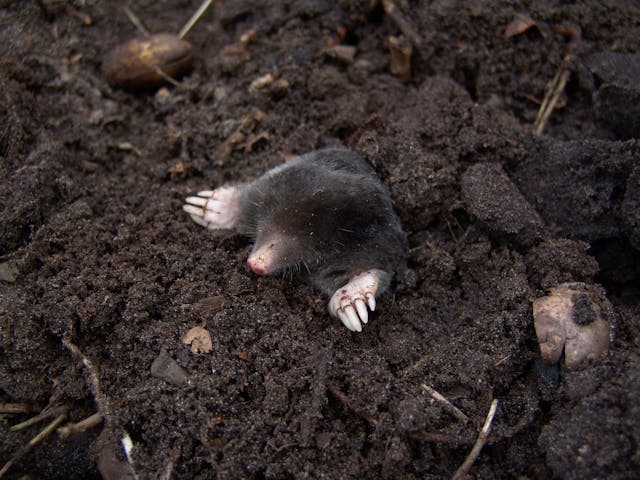
Interesting Wildlife Facts About Moles
- Moles are small, burrowing mammals known for their powerful front limbs adapted for digging.
- They spend most of their lives underground, creating extensive tunnel systems to search for food.
- Moles primarily feed on earthworms, with insects and grubs making up a smaller part of their diet, serving as natural pest controllers.
- Despite their poor eyesight, moles have an acute sense of smell and touch, which helps them navigate underground.
- Moles are generally solitary, though some species may show limited social behavior, particularly in shared territories during winter.
Nuisance Issues with Moles
- Lawn and Garden Damage: Moles create unsightly molehills and tunnels that can ruin lawns, gardens, and landscaping.
- Root Disturbance: Their digging can damage plant roots, leading to wilting or plant death.
- Structural Concerns: Extensive tunneling near foundations or irrigation systems can cause damage over time.
- Attraction of Predators: Mole activity can attract predators like snakes or foxes to your property.
- Erosion Risks: Mole tunnels disrupt soil stability, increasing the risk of erosion in certain areas.
Mole Behavior
- Burrowing Experts: Moles can dig up to 15 feet of tunnels in an hour, using their large front paws.
- Dietary Needs: They consume their body weight in insects daily, making them highly active hunters.
- Territorial Nature: Moles maintain individual territories and defend them aggressively.
- Surface Activity: While mostly underground, moles occasionally come to the surface, particularly when dispersing to new areas.
- Seasonal Activity: Moles are active year-round, but their tunneling may become more noticeable in spring and fall.
Moles and Diseases
- Ticks and Fleas: Moles may host parasites like ticks and fleas, but the risk of disease transmission to humans is relatively low, as they are not major vectors of zoonotic diseases.
- Soil Contamination: Indirect exposure to mole droppings can pose a minor health risk in some areas.
Where in the US Are Moles Found?
- Geographic Distribution: Moles are found throughout the U.S., with some species in specific regions. While absent in dry desert areas, moles can be found in high elevation areas like the Rocky Mountains.
- Preferred Habitats: They thrive in loose, moist soil rich in insects, commonly found in lawns, gardens, and fields.
- Habitat Adaptability: Moles are adaptable and thrive in areas with loose, moist soil and abundant food, such as suburban backyards and agricultural fields, though they may not do as well in highly manicured areas like golf courses.
Protecting Your Property from Moles
To prevent mole activity, maintain a healthy lawn by controlling grubs and insects, which attract moles. Compact your soil to make it less appealing for tunneling, and install barriers like underground fencing to protect vulnerable areas. If mole damage becomes a persistent issue, contact a professional wildlife removal and control service with expertise in managing burrowing species, including mole control. These professionals can provide safe and effective solutions to protect your lawn and garden from further damage.
